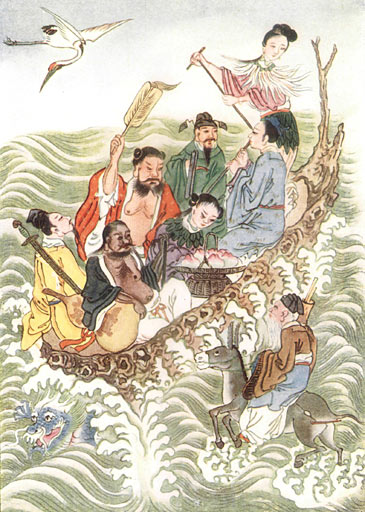
The New York Times Magazine has a great series called "Cases" where a complex or curious medical case is presented and then solved. The latest one is about tapeworm. You can
read it on the NYT website or read it below...
Cases: Tale of the Tapeworm (Squeamish Readers Stop Here)By LARRY ZAROFF, M.D.
Published: August 8, 2006
This is a Jewish fish story. Or more accurately a Jewish fishworm story.
My mother, like her mother, was an expert Jewish cook, their specialties famous in our extended family. Their secret: taste as you go. Season slowly until the perfect flavor comes through.
It’s a safe technique with latkes or kreplach but not always with gefilte fish, a ground concoction of freshwater fish, spices, eggs, salt and matzo meal.
My mother never became sick from tasting raw fish, but, by chance, gefilte fish turned out to be a formidable problem for my medical partner’s wife, Rita.
Rita was meticulous in keeping a kosher house and enjoyed making the special Jewish dishes, including gefilte fish. An unusually energetic young woman, she was able to work in the garden, clean the house, cook and support her husband’s surgical practice without effort. But she had not been feeling well for months:
abdominal symptoms of cramps, distention and occasional diarrhea, associated with increasing weakness, shortness of breath, lethargy and fatigue. Bob, her husband, was concerned enough to obtain blood work that revealed a
profound anemia: her red blood cells were in short supply. Here was a woman, in her 40’s, who ate a normal diet and took her vitamins. She had no gastrointestinal symptoms until this episode and had no obvious blood loss. What could be the cause of the anemia?
Microscopic examination of Rita’s red blood cells provided a clue. They were enlarged, with unusual structures, described as macrocytic. A common cause of this is pernicious anemia resulting from a shortage of vitamin B12 or folic acid, both necessary for the production of red blood cells. But Rita had no neurologic signs of pernicious anemia or any other systemic disease that would cause a lack of B12 or folate.
Her doctors were stumped.
Enter Dr. Earl Lipman, a close friend of Bob’s and an outstanding internist and diagnostician, who identified the culprit over the phone.
Earl asked, “Does Rita make her own gefilte fish?”
“Yes.”
“Does she ever taste the raw fish before adding salt?” Earl continued.
“Yes.”
“She most likely has a fish tapeworm.”
The fish tapeworm — a beast, stubborn as a dog with a beef bone — is reluctant to move, tightly gripping the wall of the small intestine with its two suction cups. The worm requires a powerful purging medicine to persuade it to leave its cozy cave and exit the gut into the light.
After purging, Rita discharged a tapeworm three feet long. Examination of the worm proved Dr. Lipman correct. Diphyllobothrium latum, the fish tapeworm, was identified by the pathologist. Her anemia slowly went away, and her abdominal symptoms disappeared.
The disease is unusual and the diagnosis can be hard to make. It was good fortune that Dr. Lipman had been a resident at Mount Sinai Hospital in Manhattan, where he had done research on vitamin B12.
Rita expressed her gratitude to by presenting Dr. Lipman with a large china fish platter.
The largest parasite of humans, the fish tapeworm — known for its length and the length of its life — is an ideal freeloader: compassionate, cunning, living off its host but not killing its benefactor. Often the worm causes no harm but may, as in Rita’s case, cause symptomatic anemia.
In the intestine, the worm is a fierce competitor for vitamin B12. Absorbing the vitamin for its own needs, the worm deprives the bone marrow of a vital ingredient for making red blood cells.
Tapeworms sometimes reach a length of 30 feet and can live up to 20 years. They have a complex life cycle; in adult form they attach themselves by suction cup to the small intestine of vertebrates.
The fishworm is a compact sex machine containing both male and female sex organs sufficient to produce and release up to a million eggs a day.

To survive, the eggs must reach fresh water, where they become embryos with hooks that are ingested by crustaceans. The crustaceans in turn are swallowed by fish. Freshwater fish like the pike and perch, major ingredients of gefilte fish, are especially fond of these delicacies.
Ingested, the larvae of the worms embed themselves comfortably in the muscle fibers of the fish. When humans or other vertebrates swallow the raw fish, the cycle is completed.
Though symptoms are sometimes described as the Jewish housewives’ disease, the worm is nonsectarian, and the anemia can be found in other cultures that eat raw freshwater fish.

 To survive, the eggs must reach fresh water, where they become embryos with hooks that are ingested by crustaceans. The crustaceans in turn are swallowed by fish. Freshwater fish like the pike and perch, major ingredients of gefilte fish, are especially fond of these delicacies.
To survive, the eggs must reach fresh water, where they become embryos with hooks that are ingested by crustaceans. The crustaceans in turn are swallowed by fish. Freshwater fish like the pike and perch, major ingredients of gefilte fish, are especially fond of these delicacies. 

